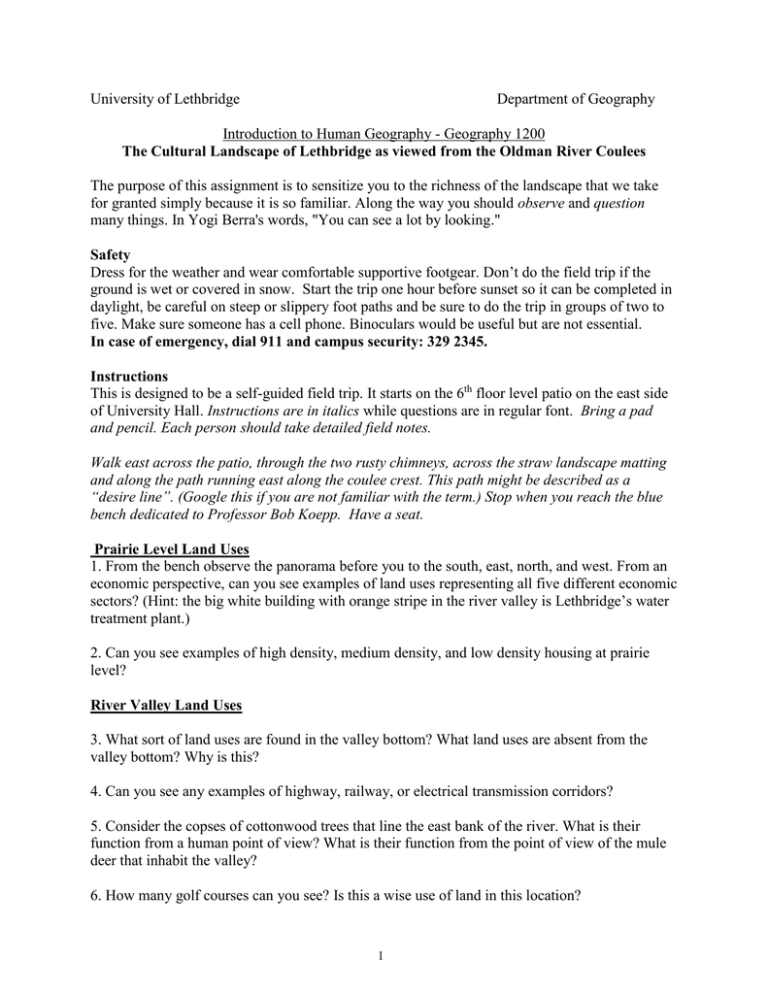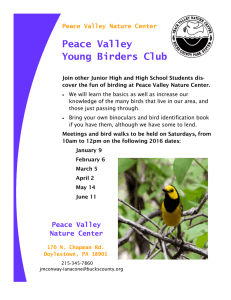University of Lethbridge Department of Geography
advertisement

University of Lethbridge Department of Geography Introduction to Human Geography - Geography 1200 The Cultural Landscape of Lethbridge as viewed from the Oldman River Coulees The purpose of this assignment is to sensitize you to the richness of the landscape that we take for granted simply because it is so familiar. Along the way you should observe and question many things. In Yogi Berra's words, "You can see a lot by looking." Safety Dress for the weather and wear comfortable supportive footgear. Don’t do the field trip if the ground is wet or covered in snow. Start the trip one hour before sunset so it can be completed in daylight, be careful on steep or slippery foot paths and be sure to do the trip in groups of two to five. Make sure someone has a cell phone. Binoculars would be useful but are not essential. In case of emergency, dial 911 and campus security: 329 2345. Instructions This is designed to be a self-guided field trip. It starts on the 6th floor level patio on the east side of University Hall. Instructions are in italics while questions are in regular font. Bring a pad and pencil. Each person should take detailed field notes. Walk east across the patio, through the two rusty chimneys, across the straw landscape matting and along the path running east along the coulee crest. This path might be described as a “desire line”. (Google this if you are not familiar with the term.) Stop when you reach the blue bench dedicated to Professor Bob Koepp. Have a seat. Prairie Level Land Uses 1. From the bench observe the panorama before you to the south, east, north, and west. From an economic perspective, can you see examples of land uses representing all five different economic sectors? (Hint: the big white building with orange stripe in the river valley is Lethbridge’s water treatment plant.) 2. Can you see examples of high density, medium density, and low density housing at prairie level? River Valley Land Uses 3. What sort of land uses are found in the valley bottom? What land uses are absent from the valley bottom? Why is this? 4. Can you see any examples of highway, railway, or electrical transmission corridors? 5. Consider the copses of cottonwood trees that line the east bank of the river. What is their function from a human point of view? What is their function from the point of view of the mule deer that inhabit the valley? 6. How many golf courses can you see? Is this a wise use of land in this location? 1 Cultural Landscape 7. Using the ideas of Carl Sauer, explain how this vista may be understood as a cultural landscape. Walk down to the brown sign south-east of the blue bench. Reading the Landscape 8. What does this sign say? What does this tell you about the function of the river valley? 9. Turn around and walk back up the valley side towards University Hall, staying near the coulee bottom. As you climb the slope, take note of the manholes. How many did you find? What is their function? Where are these manhole covers manufactured? How long has this firm been operating? (Google it.) Why are storm sewers referred to as “infrastructure”? (Hint: check the etymology of infrastructure.) Is this “hard infrastructure” or “soft infrastructure”? 10. As you climb up through the coulee bottom, observe the texture of the vegetated slopes to the north and to the south. The cardinal direction that a slope faces is known as its “aspect”. Slope aspect gains particular significance relative to the angle of the sun. Compare and contrast the north and south-facing slopes. How do you account for these contrasts? When you reach the straw landscape matting please turn left and walk around it to avoid trampling the newly germinated grass. Walk up the stairs to the patio and into University Hall. You are done! It is time to enjoy a hot drink with your partner. Ruminating A field trip report is not required. But you and your group may benefit from some post-fieldtrip discussion of what you learned from this experience and how downtown Lethbridge compares to your home town or city. Can you integrate concepts that have been taught in class, described in the course text book and experienced first-hand in the field? This will be tested in the final examination. 2


